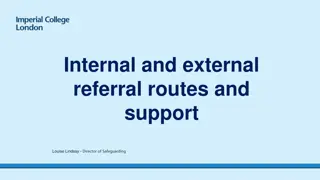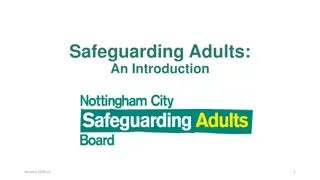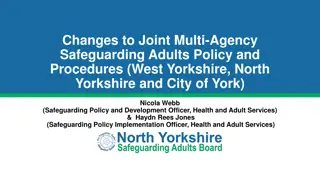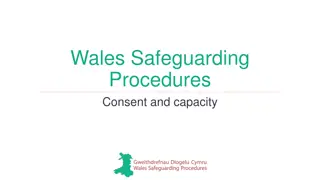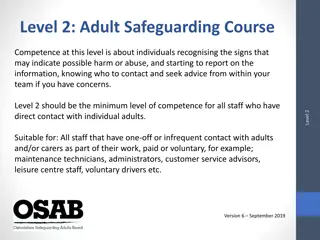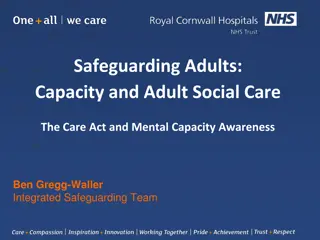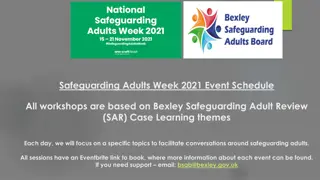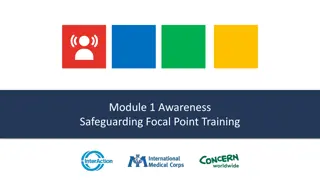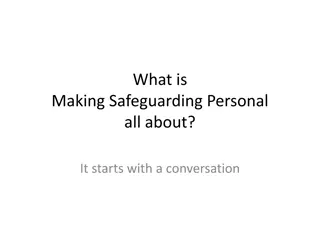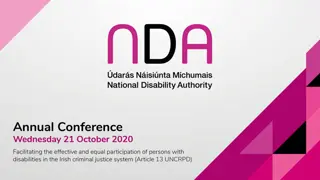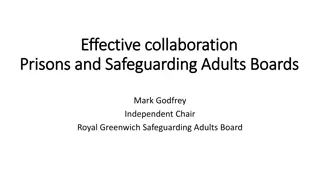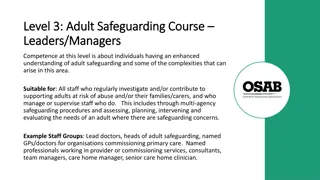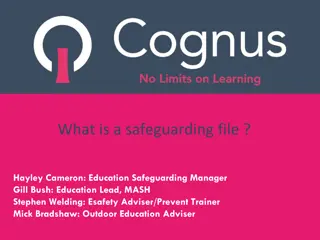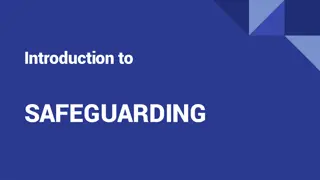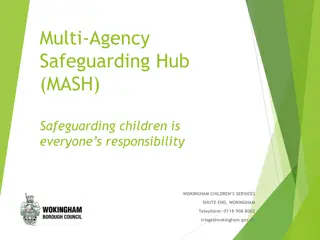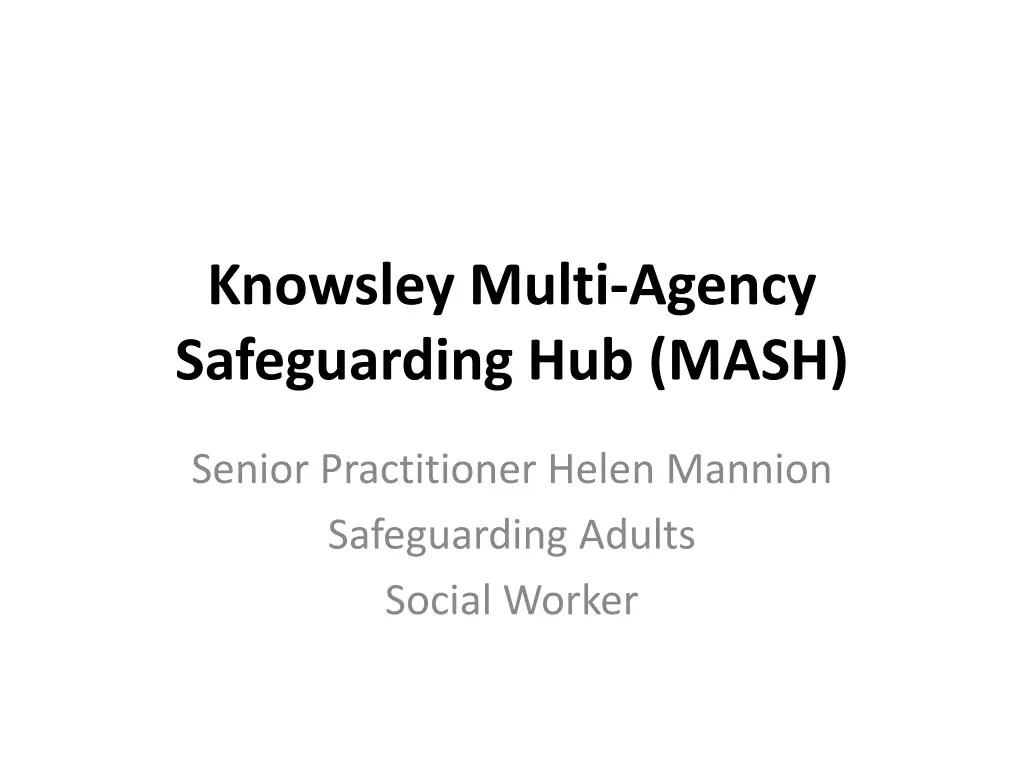
Understanding Safeguarding Adults and the Role of Knowsley MASH
Discover the importance of safeguarding adults, the function of Knowsley Multi-Agency Safeguarding Hub (MASH), and the various agencies involved. Learn about safeguarding duties, the purpose of MASH, and the significance of effective information sharing in protecting vulnerable individuals from abuse and neglect.
Download Presentation

Please find below an Image/Link to download the presentation.
The content on the website is provided AS IS for your information and personal use only. It may not be sold, licensed, or shared on other websites without obtaining consent from the author. If you encounter any issues during the download, it is possible that the publisher has removed the file from their server.
You are allowed to download the files provided on this website for personal or commercial use, subject to the condition that they are used lawfully. All files are the property of their respective owners.
The content on the website is provided AS IS for your information and personal use only. It may not be sold, licensed, or shared on other websites without obtaining consent from the author.
E N D
Presentation Transcript
Knowsley Multi-Agency Safeguarding Hub (MASH) Senior Practitioner Helen Mannion Safeguarding Adults Social Worker
What does Safeguarding Adults Mean? Safeguarding means protecting the health, wellbeing and human rights of adults at risk, enabling them to live safely, free from abuse and neglect. It is about people and organisations working together to prevent and reduce both the risks and experience of abuse or neglect. It also means making sure that the adult's wellbeing is supported and their views, wishes, feelings and beliefs are respected when agreeing on any action.
Knowsley MASH The MASH provides a first point of contact to enable members of the public and professionals to raise concerns about a child or adult at risk to the following agencies: Adult Social Care (ASC) Children s Social Care (CSC) Family First 0-18 service (FF) SHIELD (Child Exploitation and Missing Service) Reasons for referrals into MASH can vary, from neglect, sexual abuse, domestic abuse and child exploitation.
MASH consists of a number of agencies such as: Police CSC Safer Communities Team Housing Probation Health Education Each of these agencies are responsible for sharing appropriate information in relation to an adult or child where there are concerns for abuse and/or neglect.
Steven Hoskin https://youtu.be/PuHkan39KOY
Consistent Findings Lack of effective information sharing, poor decision making processes and poor communication across agencies is a significant contributing factor in the failure to safeguard and protect people
Local Authority Duty The Care Act 2014 (S.42) Safeguarding duties apply when a local authority has reasonable cause to suspect that an adult in its area: Has needs for care and support (whether or not the local authority is meeting any of those needs), and Is experiencing, or is at risk of, abuse and neglect, and As a result of those care and support needs is unable to protect themselves from either the risk, or the experience, of abuse or neglect
Local Authority Duty Local Authorities must: Make enquiries, or cause others to make enquiries (s42); Each local authority must establish a Safeguarding Adults Board (SAB) for its area (S.43). The way in which a SAB must seek to achieve its objectives is by co- ordinating and ensuring the effectiveness of what each of its member does. Arrange for independent advocacy where the person has substantial difficulty in engaging in the process
Knowsleys MASH Aim to ensure significant improvements in communication and information sharing amongst agencies Working alongside partner agencies assists in the development of informed risk assessments Enables quick and informed multi-agency decision making and identifies appropriate intervention amongst partner agencies, acknowledging that each agency has a role to play.
Making Safeguarding Personal Our response will be as individual as the person or situation Person-led Outcome-focused Engage people in conversations about their safety Enhances involvement Choice and control Improves quality of life Improve wellbeing and safety Proportionate response
What good is it making someone safer if it merely makes them miserable? Lord Justice Munby (2010) Local Authority X v MM & Anor (No. 1) (2007)
Mental Capacity and Safeguarding If someone makes a decision that you or others think is unwise or not in their interests, this does not necessarily mean that they lack the capacity to decide. There will be times when an adult who has capacity decides to accept a situation that you perceive as potentially abusive or neglectful. This is a decision that they are free to make, unless: other people are being put at risk (for example, letting friends who are abusive or exploitative into a shared living environment, where they may put other residents at risk) a child is involved the alleged source of risk has care and support needs and may also be at risk themselves a serious crime has been committed staff are implicated coercion is involved
Relevant Legislation: The Care Act 2014 The Human Rights Act 1998 e.g. Article 8 Right to a private and family life Mental Capacity Act and Deprivation of Liberty Safeguards 2005 Powers of entry Social Workers do not have these! The Court of Protection when lacking Mental Capacity The High Court Inherent Jurisdiction when coercion / undue influence is identified Mental Health Act (1983) Other agency powers Housing, Environmental Health, Police Six Principles of Safeguarding
Cuckooing/Invasion What is Cuckooing? a term signifying an unwelcome or unwanted intruder after the nest invading tendencies of cuckoo birds Criminal exploitation of vulnerable people involving the use of their homes as a base for criminal activities, through intimidation or in exchange for drugs. Victims are often lonely, isolated and vulnerable Cuckooing is often linked to the drug trade known as 'county lines', the name given to drug dealing networks connecting urban and rural areas across the UK through dedicated mobile phones
What are county lines? The Home Office defines county lines as: The police term for urban gangs supplying drugs to suburban areas and market and coastal towns using dedicated mobile phone lines or deal lines . It involves child criminal exploitation (CCE) as gangs use children and vulnerable people to move drugs and money. Gangs establish a base in the market location, typically by taking over the homes of local vulnerable adults by force or coercion in a practice referred to as cuckooing .
Case Example Mr A is a 30 year old male who lives alones Has a diagnosis of paranoid schizophrenia No family or friends Local drug dealers took over his flat and set up a cannabis farm He was subsequently arrested for possession He was referred to Operation Lampery He was criminalised He did not see himself as being exploited as he classified these individuals as friends His electricity was cut due to the drug gang tampering with his electricity supply Housing were looking to seek possession of the property due to a breach in tenancy He remained in his own home, this was his choice, after his arrest Previous incidents He was always rearranging appointments with Housing sustainability officer. A number of complaints had been made to Housing by neighbours regarding the amount of people attending his property during the day and night. Previous unprovoked attack in community by unknown persons Approximately one month after the cannabis farm find, he was assaulted in his own home by 2 males. He managed to flee the property however too fearful to return, there were concerns that these males were associated with the cannabis farm Following this he was accommodated
Our Aim We want to encourage our residents and partners to report any concerns about abuse and neglect so we can work together to ensure that the most vulnerable people in our community feel safe.
Useful Links Raise a concern: https://forms.knowsley.gov.uk/AdultSafeguarding KMBC Criteria guidance: https://www.knowsley.gov.uk/knowsleycouncil/media/D ocuments/Guidance-Criteria-for-reporting-a- Safeguarding-Adults-Concern-V5-May-19.pdf Care Act 2014 Guidance: https://www.gov.uk/government/publications/care-act- statutory-guidance/care-and-support-statutory- guidance
Knowsley Safeguarding Adults Team 0151 443 2600



